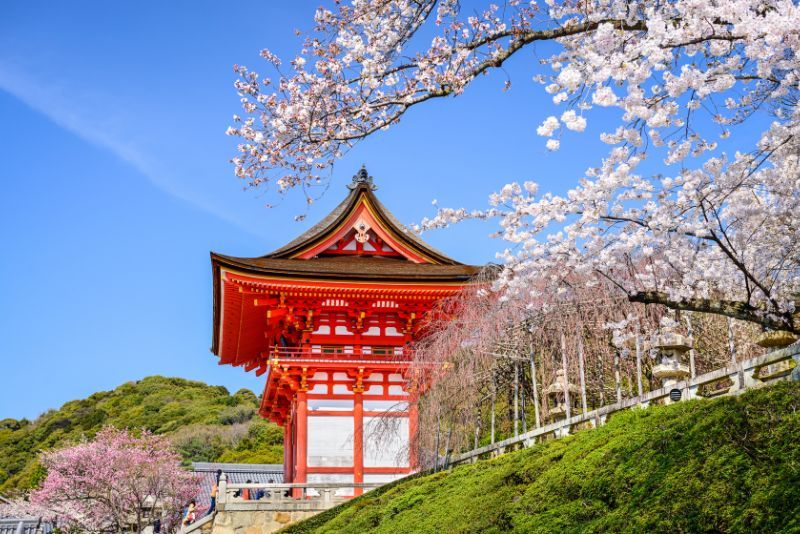Kiyomizu-dera Temple: Tickets and Tours
Founded in 778, this UNESCO World Heritage site is a must-visit destination for anyone visiting Kyoto. Without a doubt, this is one of the best places to see the famous cherry blossoms bloom in the springtime.
On a Kiyomizu-dera Temple tour, you can appreciate the architecture and serene atmosphere of this historic Buddhist temple located in the heart of Kyoto's Higashiyama district.
Founded in 778, this UNESCO World Heritage site is a must-visit destination for anyone visiting Kyoto. Without a doubt, this is one of the best places to see the famous cherry blossoms bloom in the springtime.
On a Kiyomizu-dera Temple tour, you can appreciate the architecture and serene atmosphere of this historic Buddhist temple located in the heart of Kyoto's Higashiyama district.

(0/24) checking Musement...
Founded in 778, this UNESCO World Heritage site is a must-visit destination for anyone visiting Kyoto. Without a doubt, this is one of the best places to see the famous cherry blossoms bloom in the springtime.
On a Kiyomizu-dera Temple tour, you can appreciate the architecture and serene atmosphere of this historic Buddhist temple located in the heart of Kyoto's Higashiyama district.

Here's all you need to know about Kiyomizu-dera Temple, one of the most ancient attractions in Kyoto.
How much do Kiyomizu-dera Temple tickets cost?
Although it's free to explore the outdoor area of the Kiyomizo-dera Temple, you must purchase a ticket on-site on the day of your visit to see the interior of the temple.
- Adult ticket: 400 yen (US$3)
- Child ticket: 200 yen (US$1.50)
Who is eligible for discounts?
Children who are in Junior High School or younger (under 14 years old) are eligible for a 50% discount and only need to pay 200 yen (US$1.50) for their Kiyomizu-dera Temple ticket.
Children under 6 and people with disabilities plus one companion are eligible to visit the Kiyomizu-dera Temple for free and aren't required to purchase an entry ticket.
What are the best Kiyomizu-dera Temple tours?
Full-Day Tour of Kyoto and Kiyomizu-dera Temple

If you want to visit all the top attractions in Kyoto in one day without having to worry about finding your way around, this is the tour for you. All you need to do is show up at the tour office in the morning and get on the bus.
This full-day tour will take you to Kiyomizu-dera Temple and other must-see sites, including Nijo Castle, Golden Pavilion, Kyoto Imperial Palace, Fushimi Inari Shrine and Sanjusangendo Temple.
Please note that on days that the Kyoto Imperial Palace is closed, you will visit the Kitano Tenmangu Shrine instead. Lunch is included as part of the tour price and vegetarian options are available if you request in advance.
Half-Day Tour of Kiyomizu-dera Temple and Fushimi Inari Shrine

If you want to focus your visit on two of the most popular attractions in Kyoto, the Kiyomizu-dera Temple and Fushimi Inari Shrine, this is the tour for you. Whether by foot and public transport or in a private vehicle, these tours reveal the best there is to discover in the temple and shrine.
Choose the early bird tour if you prefer to start your day before 8 AM. This is a great idea to both beat the heat in the summer and avoid the biggest crowds any time of the year. After the tour, you'll have plenty of time to decide where to have lunch possibly at one of the hundreds of options at Nishiki Market.
Otherwise, if you want to sleep in, you can choose to start your tour in the early afternoon. You'll start at the Fushimi Inari Shrine before making your way to two temples — Sanjusangendo and Kiyomizu-dera. The latter has a terrace with panoramic views of Kyoto, and you'll be there at the perfect time to see the sunset.
Jogging Tour of Kyoto and Kiyomizu-dera Temple
This Kiyomizu-dera Temple tour is reserved for the runners, as you'll be jogging from site to site around Kyoto. Over the course of a few hours, you'll need to run about 15 kilometers, so make sure you are in good enough shape to keep up with your athletic guide.
If you didn't pack your running gear, don't worry. You can rent running shoes or a running belt for 1,000 yen (US$7) each. Now you have no excuses not to make your vacation a physically fit one.
On this tour, you'll run along the Kamo River until reaching the Kiyomizu-dera Temple. Then, you'll proceed to the Yasakanoto five-story pagoda, which you might have seen in Kyoto promotional materials.
After, you can take a short rest at Maruyama Park before heading to the Nanzenji Temple and continuing through Philosopher's Walk — a path known for being popular among some of the great Japanese philosophers. Maybe that runner's high will give you an epiphany, or at least an appetite to try a hearty portion of Kyoto's cuisine.
What will you see inside?
Nio-mon Gate
Upon entering Kiyomizu-dera Temple, you will first see the Nio-mon Gate, which is a grand entrance featuring two fierce-looking Nio guardian statues. These statues are believed to ward off evil spirits and protect the temple grounds.
Deva Gate and Three-Storied Pagoda
After passing through the Nio-mon Gate, you will come across the Deva Gate, which leads to the temple's main hall. Nearby, the beautiful Three-Storied Pagoda stands tall with its bright red and white colors, making it an iconic landmark of Kiyomizu-dera.
Main Hall and Stage
The temple's main hall, known as the Hondo, houses the main object of worship – a statue of the Thousand-Armed Kannon. The hall is connected to a large wooden stage called the Kiyomizu Stage, which offers stunning views of the surrounding area, particularly during cherry blossom and autumn foliage seasons.
Jishu Shrine
Located behind the main hall, Jishu Shrine is dedicated to the god of love and matchmaking. Visitors can participate in various rituals and customs, such as walking blindfolded between two stones in hopes of finding true love.
Otowa Waterfall

One of the Kiyomizu-dera Temple's most famous features is the Otowa Waterfall, where three streams of water fall into a pond. Visitors can use cups attached to long poles to drink the water, which is said to have healing properties and bring good fortune.
Koyasu Pagoda
A short walk from the main hall, the Koyasu Pagoda is a three-storied structure known for granting safe childbirth and easy pregnancy. Many expectant mothers visit this pagoda to pray for a smooth and healthy delivery.
Shops and Tea Houses
Throughout the temple grounds, you will find various shops selling traditional Japanese souvenirs, snacks, and local crafts. There are also several tea houses where you can enjoy a cup of matcha green tea and Japanese sweets while admiring the temple's serene atmosphere.
Seasonal Events and Illuminations
Kiyomizu-dera hosts various seasonal events, such as the cherry blossom and autumn foliage illuminations. During these events, the temple and its surrounding gardens are illuminated with colorful lights, creating a magical atmosphere that attracts both locals and tourists.
How to get there?
Kiyomizu-dera Temple is located in the eastern part of Kyoto, in the Higashiyama district. It is not situated in the city center and is not directly accessible by metro. However, there are several ways to reach the temple, including walking, train, electric tram, and bus.
On foot
From Kyoto's city center, Kiyomizu-dera Temple is approximately a 30-minute walk. You can take a leisurely stroll through the historic Higashiyama district, passing by traditional shops and tea houses along the way. This walk is particularly enjoyable during the cherry blossom and autumn foliage seasons.
By train
While there is no metro station directly at Kiyomizu-dera, the closest train station is the Kiyomizu-Gojo Station on the Keihan Main Line. From this station, it is about a 20-minute walk to the temple. To reach Kiyomizu-Gojo Station from Kyoto Station, take the JR Nara Line to Tofukuji Station and transfer to the Keihan Main Line.
By electric tram
The Randen tram line is another option to reach the temple. From Shijo-Omiya Station in central Kyoto, take the Randen tram to Katabiranotsuji Station. From there, transfer to the Randen Higashiyama Line and get off at Higashiyama-Yasui Station. The temple is about a 15-minute walk from the station.
By bus
Kyoto's city buses provide convenient access to Kiyomizu-dera Temple. From Kyoto Station, take bus number 100 or 206 and alight at the Gojo-zaka or Kiyomizu-michi bus stop. The temple is a 10 to 15-minute walk uphill from either of these stops.
What are the opening times?
For most of the year, Kiyomizu-dera Temple is open from 6 AM to 6 PM. However, it remains open half an hour later during the second half of August. Also, there are special night viewing days in the spring (March 25 - April 2), summer (August 14-16) and fall (November 18-30) when the temple stays open until 9:30 PM.
When is the best time to visit the Kiyomizu-dera Temple?
Visiting Kiyomizu-dera Temple early in the morning allows you to enjoy the serene atmosphere before the crowds arrive. This is particularly enjoyable during the quieter seasons, such as winter or summer.
The best time of the year to visit is in the spring and autumn. From late March to early April, the cherry blossoms adorn the temple grounds in lovely shades of pink. From mid-November to early December, the fall foliage sets a serene tone to the landscape.
Travel tips
- Attend seasonal events. Kiyomizu-dera hosts several seasonal events, such as cherry blossom and autumn foliage illuminations, which are great ways to appreciate the area's natural beauty.
- Participate in temple rituals. Immerse yourself in the spiritual atmosphere of Kiyomizu-dera by participating in temple rituals, such as making offerings, lighting incense or drinking water from the Otowa Waterfall.
- Combine with other attractions. The Higashiyama district is home to several other temples and attractions. Plan your day to include other nearby sites, such as the Kodai-ji Temple or Yasaka Shrine, to make the most of your visit to the area.
